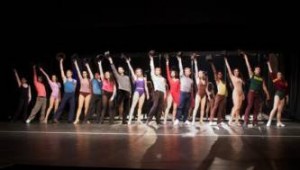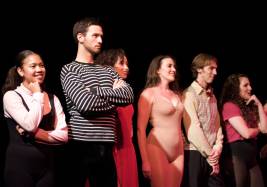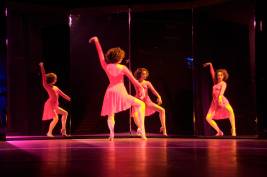
Try to think of a musical where the hopes, fears, challenges, and dreams of a dozen and a half characters are explored in dialog, song, and dance … and chances are the first (and possibly only) show that will come to mind is A Chorus Line, the first Broadway musical to explore the intimate stories of Broadway’s “gypsies”—while dealing with race and sexuality and featuring big, flashy production numbers to boot. Just as Oklahoma! and West Side Story revolutionized Broadway in the 1940s and ‘50, so too did A Chorus Line change the face of musical theater two decades later.
With a record-breaking Broadway run of over 6000 performance and a grand total of nine Tony wins, A Chorus Line (book by James Kirkwood, Jr. and Nicholas Dante, music by Marvin Hamlisch, lyrics by Edward Kleban) proved not only a smash on the Great White Way and throughout the world, but has become a favorite of regional, school, and community theaters across the country.
A Chorus Line is a tough show to do right. It is, after all, the story of seventeen Broadway-caliber dancers, most of whom have New York and National Tour credits, and face it, about the only place you’ll find a stageful of this level triple threats is in a Broadway production, a First National Tour, or a major Equity regional production. There are theaters who should never even attempt A Chorus Line, and I’ve seen at least one such production, though thank goodness I did not have to review it.
Fortunately, Santa Monica’s venerable Morgan-Wixson is not one of those theaters. Though most of its cast members are a good five to ten years younger than the characters they are playing, they are a talented bunch of (mostly) BFA students and grads giving their all to this production. The result, while not the caliber of the Broadway National Tour which played the Ahmanson exactly two years ago, is nonetheless a production its director, choreographer, and performers can be proud of. Under Anne Gesling’s assured direction and musical direction, this is a perfectly fine introduction to A Chorus Line for newbies and an entertaining return visit for longtime fans.
The opening number “I Hope I Get It” still packs the same punch as ever, with its two-dozen auditioners executing those signature Michael Bennett leaps as recreated—smashingly—by choreographer (and A Chorus Line vet) Hector Guerrero.
A delightfully cocky Erik Bradley sings and dances Mike’s “I Can Do That.” Jonathon Saia does nicely with flamboyant Bobby’s monolog about growing up “different” (i.e. gay, though he never actually says so) in Buffalo, New York. “At the Ballet” has Sheila (Elizabeth Hunter, with just the right hauteur for the role) and the cute duo of Brittany Sindicich (Bebe) and Michelle Akeley (Maggie) reminiscing in song and dance about the influence ballet has had on their lives. As Kristine, Kaeli Carr proves an adorable comedienne in “Sing!” (which poor Kristine can’t), backed up by hubby Al (Julian McCleary, who can). A series of three Montage sequences feature the nostalgic “Hello Twelve, Hello Thirteen, Hello Love,” “Mother” sung sweetly by Akeley, and Richie’s brash “Gimme The Ball,” spotlighting the R&B talents of Jacob Nixon.
Three of the women get big solo numbers. Amy Coles nails Diana’s look back at her disastrous high school drama class with Mr. Karp in “Nothing,” and soars vocally in the iconic “What I Did For Love.” Saucy, sexy Erin Brittney Green brings down the house with her “Dance Ten Looks Three.” As Cassie, the lone auditioner to have achieved a modicum of stardom, Ashley Matthews proves a dynamic dancer recreating the moves inspired by the Broadway original, Donna McKechnie.
As always, the show’s standout dramatic moment belongs to Paul, whose Act Two monolog also provides the show’s toughest acting challenge. Eric De Anda meets this challenge … and then some, delivering Paul’s reminiscences about his post high school dropout life as a teen dancer in drag with a spontaneity and honesty that prove heart-wrenching.
Completing the cast of competitors are Steve Weber (Don), Chyka Jackson (Connie), Jayson Farrar-Puls (Gregory), understudy Brenda Stevens (Judy), and Michael Marchak (Mark), each of whom has his or her standout scene.
A mostly offstage Michael Heimos proves his versatility as director Zach, the character based on Bennett, and Matthew Prieur displays fine dancing skills as Zach’s assistant Larry.
Meghan Aguilar, Jessica Breslow, Mirai Booth-Ong, Donovan Cooper, Steven Flowers, Ariel Neydavoud, and Glenn Rodriguez do well in the show’s opening number before being sent off to audition for another show.
Thomas A. Brown’s set design recreates the 1975 original, possibly the simplest in Broadway history—a bare stage backed with a wall of mirrors, professionally lit by William Wilday. Gesling clothes the cast in the Theoni V. Aldredge-inspired designs we’ve come to associate with each character, with those gold lame finale costumes provided by Costume World International. Gesling is also in charge of the sound design, which—thanks in large measure to the Morgan-Wixson’s excellent acoustics—allows us to hear the performers’ unamplified voices quite clearly whether speaking or singing along to the production’s prerecorded background tracks.
Mary Beth Sciarabba is producer, All Hobbs prop designer, Thomas A. Brown technical director, and Vashti Emigh stage manager.
Morgan-Wixson’s A Chorus Line is a reminder of just how great (and surprisingly timeless) this musical remains thirty-five years after its Broadway debut. “Kiss today goodbye and point me toward tomorrow. We did what we had to do. Won’t forget, can’t regret what I did for love.” It’s quite something indeed what aspiring musical theater talents like the ones in A Chorus Line and those on the Morgan-Wixson stage will do for love.
Morgan-Wixson Theatre, 2627 Pico Boulevard, Santa Monica.
www.SantaMonicaMusicals.com
–Steven Stanley
July 2, 2010





 Since 2007, Steven Stanley's StageSceneLA.com has spotlighted the best in Southern California theater via reviews, interviews, and its annual StageSceneLA Scenies.
Since 2007, Steven Stanley's StageSceneLA.com has spotlighted the best in Southern California theater via reviews, interviews, and its annual StageSceneLA Scenies.







 COPYRIGHT 2024 STEVEN STANLEY :: DESIGN BY
COPYRIGHT 2024 STEVEN STANLEY :: DESIGN BY